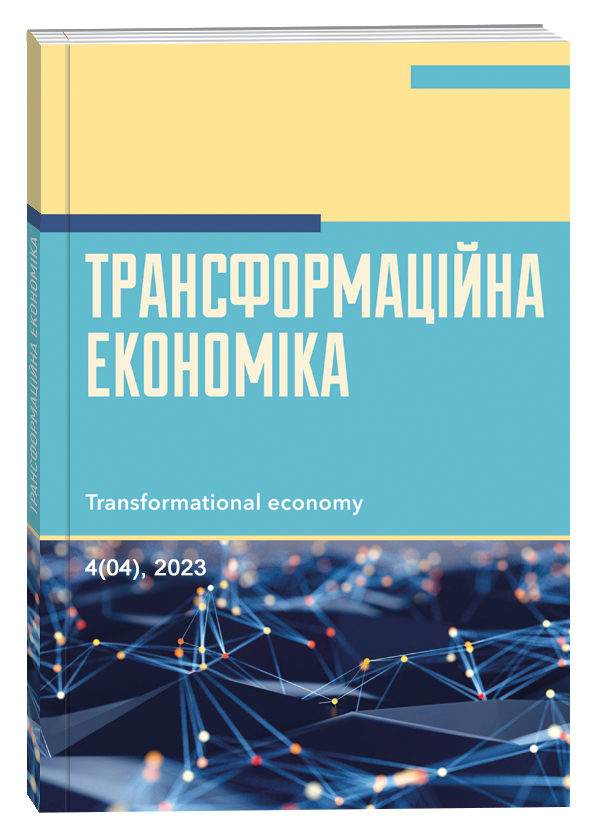GRANTS FOR FINANCING MICRO-SMALL AND MEDIUM-SIZED BUSINESSES: SWOT-ANALYSIS
Abstract
The article deals with the main grant instruments for representatives of micro, small and medium businesses of Ukraine as an achievement of the Central Development Strategy until 2030. The international community has established a list of sustainable development goals (SDGs) that must be achieved by 2030, including: protecting the planet, overcoming poverty and hunger, developing agriculture, ensuring good health and well-being, etc. One of the challenges in achieving the SDGs is the financing of some projects to implement these goals. Traditional sources of financing, such as own, credit, investment resources, may not be sufficient to cover the significant costs associated with achieving the SDGs. Therefore, there is an urgent need to attract alternative financing mechanisms to support the implementation of projects that work to achieve the SDGs. Grants are one of the alternative sources of funding for SDG projects. In recent years, the interest of representatives of micro-small and medium-sized enterprises in grant instruments as a method of increasing business competitiveness has increased significantly. However, a low level of the culture of using grant resources can provoke negative consequences in the form of non-use of some opportunities of grant instruments for effective achievement of the SDGs. Examples of effective grant tools for micro, small and medium-sized businesses, as well as European Commission programs (Horizon Europe (HORIZON), Creative Europe (CREA), Erasmus+ (ERASMUS+), Digital Europe Programme, EU4Health Programme, Program for the Environment and Climate Action, Single Market Programme), USAID, IOM, "eRobota". A SWOT analysis was carried out to assess the strengths and weaknesses, opportunities and threats of using grant instruments as a financing mechanism for SDG projects. The conducted analysis provides valuable information about your advantages and disadvantages of using grant resources to finance SDG projects and determining a strategy for managing possible risks. This study aims to contribute to the wider discourse around alternative financing mechanisms for sustainable development.
References
17 Цілей сталого розвитку. URL: https://globalcompact.org.ua/tsili-stijkogo-rozvytku/
Funding & Tender Portal. Find calls for proposals and tenders. URL: https://ec.europa.eu/info/funding-tenders/opportunities/portal/screen/home
Беззубко Б., Беззубко Ю. Міжнародна технічна допомога для України. Галицький економічний вісник. № 3 (64) 2020. С. 210–216. URL: https://elartu.tntu.edu.ua/bitstream/lib/32493/2/GEB_2020v64n3_Bezzubko_B-International_technical_210-216.pdf
Кобеля-Звір М.Я. Посібник «Як отримати грант. Методика та стратегія залучення грантових ресурсів». 2022. 268 с.
Мар’янович М.Е. Міжнародна технічна допомога та її роль у забезпеченні сталого розвитку. URL: https://ekmair.ukma.edu.ua/server/api/core/bitstreams/0fd2f91b-9fd2-42d8-89e0-d1381bcfbf50/content
Офіційний сайт Міжнародної організації праці в Україні. URL: https://ukraine.iom.int/uk/mom-v-ukrayini
Постанова Кабінету Міністрів України від 15.02.2002 № 153 «Про створення єдиної системи залучення, використання та моніторингу міжнародної технічної допомоги». URL: http://surl.li/jgmob
Програма єРобота. URL: https://erobota.diia.gov.ua/#start
Програма USAID з аграрного і сільського розвитку (АГРО). URL: https://mailchi.mp/6a6c9e43415a/usaid-agro-activity-in-ukraine?fbclid=IwAR3ihafNn9wnQLKFACp9C037t672p731gd5NQGUcH-6XGx0nUb8M2UeNKpU
Центр розвитку «ЧАС ЗМІН». URL: http://www.chaszmin.com.ua/granty-2023/
17 Tsilej staloho rozvytku [17 Sustainable Development Goals]. Available at: https://globalcompact.org.ua/tsili-stijkogo-rozvytku/
Funding & Tender Portal. Find calls for proposals and tenders. Available at: https://ec.europa.eu/info/funding-tenders/opportunities/portal/screen/home
Bezzubko B., Bezzubko Yu. (2020) Mizhnarodna tekhnichna dopomoha dlia Ukrainy [International technical assistance for Ukraine]. Galician economik journal, no. 3 (64), pp. 210–216. Available at: https://elartu.tntu.edu.ua/bitstream/lib/32493/2/GEB_2020v64n3_Bezzubko_B-International_technical_210-216.pdf
Kobelia-Zvir M.Ya. (2022) Posibnyk «Yak otrymaty hrant. Metodyka ta stratehiia zaluchennia hrantovykh resursiv» [Guide «How to get a grant. Methodology and strategy of attracting grant resources»]. 268 p.
Marianovych M.E. Mizhnarodna tekhnichna dopomoha ta ii rol u zabezpechenni staloho rozvytku [International technical assistance and its role in ensuring sustainable development]. Available at: https://ekmair.ukma.edu.ua/server/api/core/bitstreams/0fd2f91b-9fd2-42d8-89e0-d1381bcfbf50/content
Ofitsijnyj sajt Mizhnarodnoi orhanizatsii pratsi v Ukraini [Official website of the International Labor Organization in Ukraine]. Available at: https://ukraine.iom.int/uk/mom-v-ukrayini
Postanova Kabinetu Ministriv Ukrainy vid 15.02.2002 № 153 «Pro stvorennia iedynoi systemy zaluchennia, vykorystannia ta monitorynhu mizhnarodnoi tekhnichnoi dopomohy» [Resolution of the Cabinet of Ministers of Ukraine dated February 15, 2002 No. 153 «On the creation of a unified system of attraction, use and monitoring of international technical assistance»]. Available at: http://surl.li/jgmob
Prohrama ieRobota [The program is Work]. Available at: https://erobota.diia.gov.ua/#start
Prohrama USAID z ahrarnoho i sil's'koho rozvytku (AHRO) [USAID Program for Agrarian and Rural Development (AGRO)]. Available at: https://mailchi.mp/6a6c9e43415a/usaid-agro-activity-in-ukraine?fbclid=IwAR3ihafNn9wnQLKFACp9C037t672p731gd5NQGUcH-6XGx0nUb8M2UeNKpU
Tsentr rozvytku «ChAS ZMIN» [«TIME OF CHANGE». development center]. Available at: http://www.chaszmin.com.ua/granty-2023/


